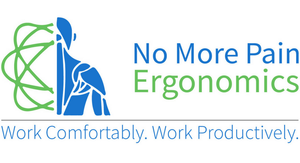-
Shop
- 🔥 Warehouse Clearance Sale 🔥
- Ergonomic Mice
- Ergonomic Keyboards
- Specialised Ergonomic Mice
- Standing Desks
- Ergonomic Chairs
- Laptop Stands & Risers
- Monitor Risers
- Computer Monitor Arms
- Footrests
- Wrist and Forearm Supports
- Back Supports
- Tablet Accessories
- Boardroom Chairs
- Headsets
- Other Ergonomic Equipment
- Online Ergonomic Training Courses
- New Products

- For Customers
- For Business Customers
- For Health Professionals
- About Us
- Reviews
Neck Pain
Ergonomic Considerations
What is Neck Pain?
Neck Pain is a painful repetitive strain injury (RSI) that affects the muscles around your neck and shoulders. Neck pain is a common ergonomic complaint. Neck muscles can be strained from poor posture — such as leaning over your computer or turning to view your second computer monitor.
Symptoms
Aching pain in the muscles around the neck
Sharp pain when moving your neck
Tightness in the neck and shoulder muscles
Tension headaches and migraines
The neck muscle pain can be caused by the following neck muscles becoming tight:
Scalene muscles (deep neck muscles that help rotate the neck)
Suboccipital muscles (deep muscles at the base of the occipital bone that are used to rotate the head)
Pectoralis minor muscles (small muscle contained within your "pecs")
Subscapularis muscles (a muscle behind your scapular that attaches into the shoulder joint)
Levator scapulae muscles (a pair of muscles located at the back and side of the neck).
What Causes Neck Pain?
Poor posture is the number one cause of neck pain. Poor posture over time leads to strain on the neck and shoulder muscles which then leads to muscle fatigue and tightness.
The most common condition that contributes to neck pain is forward protruding head and shoulder posture.
Forward head protruding posture is when the head slumps forward placing the head in front of the shoulders. This head position leads to several problems:
The weight of the head pulls on the neck and shoulder muscles and places stress on the vertebrae of the lower neck.
This position is often also coupled with forward slumped shoulders and a rounded upper back, which not only worsens the neck pain but can also cause shoulder pain.
The more time you spend with your head forward slumped, the more likely it is that you will develop neck and shoulder pain.
How is Neck Pain Treated?
Treatment for Neck Pain is aimed at reducing the pain symptoms by reducing the tightness and strain on the associated muscles. Review with a Physiotherapist is highly recommended as soft tissue therapy will assist with relieving the symptoms. Other treatment may include application of heat pack to the neck and posture reversing / correcting stretches.
What Ergonomic Equipment is Recommended for Neck Pain?
It is important to consider your working environment when looking at treating Neck Pain. We recommend you consult with a Physiotherapist, in order to get a definitive diagnosis and any treatment that you may require.
Many people with Neck Pain have poor posture due to the setup of their workstation.
Computer Monitor
Ensure your computer monitor is positioned at the correct height. The top 1/3rd of the screen should be in line with your eyes when you have your head over neck (i.e. straight and ears over shoulders), so that way you look directly forward and can see what you are working on. If your monitor needs to be raised, you may want to invest in a monitor raiser with height adjustable feet, such as the EyeRiser Multipurpose Laptop & Monitor Riser.
EyeRiser Monitor Riser
The EyeRiser Monitor Riser will help you to adjust the height of your monitor or laptop. It features height adjustable feet and a built in laptop stand.
Height Adjustable Feet
Built in Laptop Stand
Ideal for Neck Pain
Laptop Riser
The Laptop Riser will help you raise the height of your laptop screen. Simply place your laptop into the stand and adjust the angle to suit your required height.
Height Adjustable
Suits All Laptops
Ideal for Neck Pain
Ergonomic Keyboard
Ensure your keyboard and mouse are positioned within easy reach of your body. If you are reaching forward to access these items, your shoulders will naturally slump forward over time. Aim to keep your elbows by your side and close to your body.
If your mouse is positioned too far away from your body due to the keyboard being too wide, you may want to invest in a compact mini ergonomic keyboard so you can reposition your computer mouse within easy reach.
Ease Compact Keyboard
The Ease Compact Keyboard is ultra slim and thin. This will help you reposition your computer mouse within easy reach.
Wireless Model
Low profile keys
Ideal for Neck Pain
Ergo Keyboard Combo
The Ergo Keyboard Combo is a compact ergonomic keyboard paired with a wireless numeric keypad. It is ultra thin and has low profile keys meaning less wrist extension when data entering. It is another great option for users wanting to reposition their computer mouse closer.
Wireless or Wired Models
Low profile keys
Ideal for Neck Pain
Sitting Posture
Ensure your back is sitting against the back rest on your chair. After all, that is what it is there for. Sitting on the edge of your chair with no or limited back support will lead to the forward head slumping posture you want to avoid. Your back rest should have sufficient height that it provides support up to the base of your neck/shoulders. If you require an ergonomic chair with a high backrest we recommend the Endeavour 103 Ergonomic Chair.
Endeavour 103 Ergonomic Chair
The Endeavour 103 Ergonomic Chair is the perfect ergonomic chair for users wanting a comfortable chair with several ergonomic features. It has a high back rest as standard, a triple band lumbar support and seat pan slide. This chair will help you to sit with better posture.
7 Year Warranty
Seat Pan Slide
Ideal for Neck Pain







